How To Repair Large Hole In Drywall Ceiling
How to Repair Large Wall and Ceiling Holes
The following method will work to fix large holes of a foot or more in drywall walls and ceilings. This process won't work on lath plaster, try one of the plaster repair techniques on this page instead. This drywall repair process requires the use of added wood framing to hold the new patch in place. To repair smaller wall holes of several inches in both drywall and plaster without adding framing, try the repair process at this link. Check the bottom of this page for a video of this wall and ceiling repair technique.
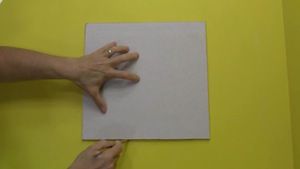
Use a piece of drywall the same thickness as the wallboard. Cut a square piece a bit larger than the damaged area and hold it over the hole to trace the outline onto the wall.
Cut Out the Square Hole
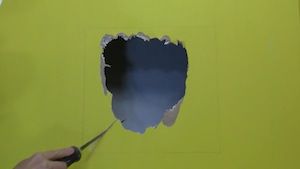
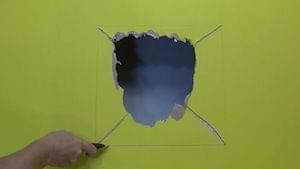

Use a drywall saw to cut from inside the hole, out to each corner of the square. Cut a bit past the pencil mark at each corner to be sure the new drywall patch will fit easily without forcing.
Score the pencil lines around the hole with a sharp utility knife. Cut just a bit outside the lines to keep the squared hole large enough for the new patch to fit easily.
Snap off the sides of the damaged wallboard, pushing into the hole along the score lines. Cut through to the backing paper and remove the damaged pieces along each side of the squared hole.
Install the Wood Frame
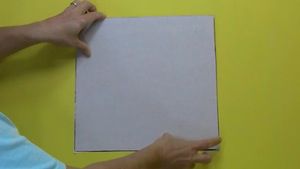
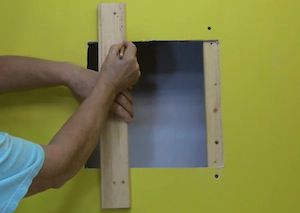
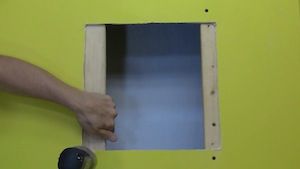
Hold the new drywall patch in place to check that it fits into the new hole easily without being forced. If necessary, trim around the edges of the hole to remove any obstructions that prevent a good fit.
Measure the opening of the squared hole and cut two furring strips, 6 inches longer than this measurement.
Hold each board against the squared hole and mark it with a pencil to indicate the edge of the hole. Make the mark so it will be visible when the board is held against the inside of the wall.
Insert each furring strip into the hole, placing it so the wall along the side of the square partially covers it. Using the marks for positioning at the top and bottom, attach the wood strip by driving drywall screws with a drill-driver through the wallboard and into the wood behind.
Keep the wood pressed tightly to the inside of the wallboard while driving the screws to avoid leaving a gap between the strip and the wall. Sink the screw heads just below the wall surface so they don't stick out and interfere with the patching compound.
Install the Drywall Patch
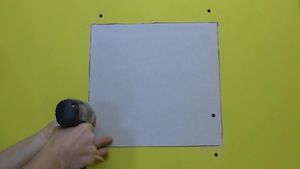
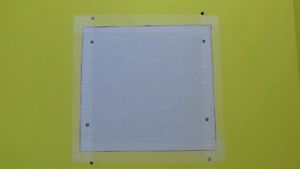
Place the new piece of drywall over the new framing and attach it with screws. Use at least 4 screws, one at each corner and sink the heads below the surface of the drywall patch.
Cover the seams around the new patch with fiberglass mesh tape. Overlap the ends at each piece of tape at the corners.
Apply a First Coat of Joint Compound
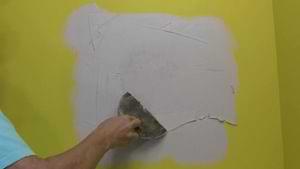
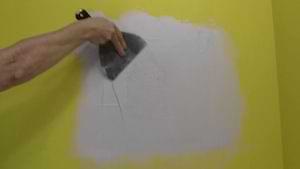
We use a 30 minute setting-type joint compound for the first two coats of this repair. The third and final coat is made using ready-mixed compound for easier final sanding and a smoother finish.
See these instructions to mix up a pan of setting compound, also called mud, and use a 6 inch joint knife to apply a first coat. "Butter" the surface with a thick coat that covers the tape and the surrounding wall surface.
Immediately go back and skim off the excess mud to leave a semi-rough coat behind. Go over the patch a couple times to remove most of the mud. Don't try to hide the tape or level out the wall with this first application, it will take a couple more coats to build up a smooth, level surface. Just use this coat to stick the tape down and start to blend the new patch with the surrounding wall.
Apply a Second Coat of Compound
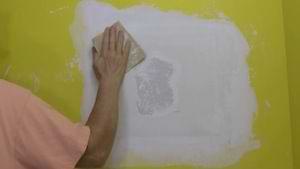
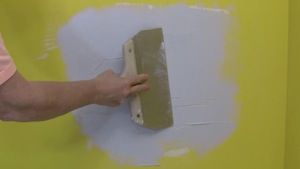
Let the mud set until it is dry to the touch and then lightly sand the tape with medium grit sandpaper. Go easy with the sandpaper to just knock off any mesh fibers and ridges in the mud, don't dig into the fiberglass. Lightly wipe off the sanding dust with a damp rag.
Mix and apply a second coat of setting compound. Use a wider joint knife this time to spread a thick coat over the whole patch and spread it out to overlap the first coat.
Immediately go back over it to skim off the excess using parallel strokes from one side to the other. Try to make the mud level with the surrounding wall as much as possible, but don't let it protrude past the wall level. Ignore any ridges left by the edge of the blade between strokes, you can knock them off before applying the next coat. Allow the mud to set until completely hard.
Apply a Third Coat of Compound
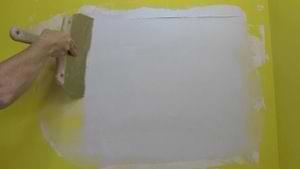
Scrape off any ridges in the mud using an upward stroke of the joint knife to shave them off. Sand if necessary to remove any other roughness and wipe off the dust.
Apply a third coat of mud over the whole patch using ready-mixed joint compound. Use the same method of applying a thick coat first and then skimming off the excess to smooth the surface. To aid in getting a level surface, stroke in the opposite direction of the previous coat. If you skimmed the mud horizontally before, skim with vertical strokes this time.
Sand and Touch Up the Paint
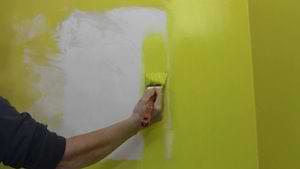
After the mud dries apply another coat, if necessary, to fill any scratches or pits in the surface, don't try to sand these out, you'll make the surface uneven. If another coat is needed, sand lightly, wipe off the dust, and apply the mud going perpendicular to the previous coat.
Allow the final coat of mud to dry completely and then sand the whole area. Use medium sandpaper to sand the patch and feather the edges into the surrounding surface.
Wipe away the sanding dust with a damp rag and touch up the paint over the repair. If you are using flat latex finish paint, it will be self-priming. If you are using semi-gloss or other shiny finish paint, prime the patch first with flat latex paint or a latex primer before touching up.
- How to Repair Bubbling Paint
- How to Repair Torn Drywall Paper
- Repairing Water Damaged Drywall
- Repairing Water Damaged Plaster
- Repairing Crumbling Plaster
- Repairing Major Plaster Damage
- Repairing Wood Lath Plaster
- Repairing Drywall Nail Pops
- Repairing Small Wall Holes
- Repairing Large Wall Holes
- Repairing Large Ceiling Holes
- Repairing Small Ceiling Holes
- Repairing Wall and Ceiling Cracks
- Repairing Cracks with Expanding Foam
- Installing a Drywall Ceiling
- Finishing Recessed Drywall Joints
- Finishing Metal Drywall Corner Bead
- Finishing Paper Corner Bead
- Finishing Inside Drywall Corners
- Finishing Drywall Butt Joints
- How to Do Drywall Texturing
- Skim Coating on Walls and Ceilings
- Sanding Drywall Joint Compound
- Wall Tools and Materials Guide
How To Repair Large Hole In Drywall Ceiling
Source: https://www.do-it-yourself-help.com/how-to-repair-large-wall-ceiling-holes.html
Posted by: minterchapill.blogspot.com

0 Response to "How To Repair Large Hole In Drywall Ceiling"
Post a Comment